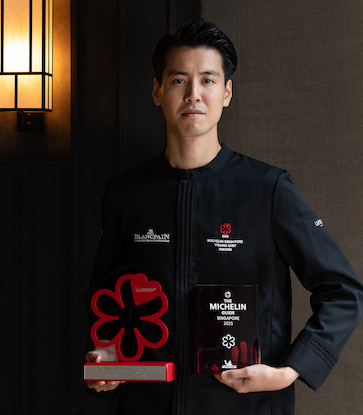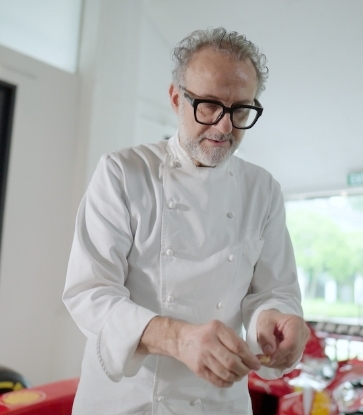Born into a restaurateur family in 1971 in a small village near Barcelona, Ramón Freixa grew up surrounded by the sights, smells and sounds of the kitchen. After spending three years at the Higher School of Hotel, Catering and Tourism of Sant Pol de Mar (Barcelona), Ramón honed his skills at leading restaurants in Belgium and France. In 1994, he returned to his family restaurant El Racó d’en Freixa in Barcelona.
Four years later in 1998, his father retired and he took over the helm and proceeded to revamp and modernise the menu. Despite the drastic change, he managed to maintain the Michelin star the restaurant was awarded ten years earlier in 1988.

Your parents started a restaurant when you were younger where your father is the chef and your mother is the maitre d'. How did growing up in a restaurateur family influence your cooking and the way you run your own restaurant today?
The moment that my parents opened a restaurant was something that changed my life forever. I remember gastronomic travels with them and my sister when I was lucky enough to try my first three-Michelin-starred restaurant when I was just seven years old – you could truly call me a young foodie!
The most valuable lesson I have learned from my parents it is to stay faithful to your own way of understanding cuisine and gastronomic philosophy, along with three essential ingredients: work, work and work. As painter Pablo Picasso once said, inspiration exists, but it has to find you working. My parents are still running Freixa Tradició restaurant today, so I am still constantly learning.
You are known for cuisine inspired by your childhood. What are some of your favourite childhood memories that have stirred some ideas in the kitchen?
As in the famous ‘episode of the madeleine’ chapter in Marcel Proust’s novel In Search of Lost Time, early memories come to my mind through senses and they can inspire a dish in many different ways.
I grew up in my grandparents' bakery in small village near Barcelona, smelling of flour and playing games with the customers as I pretended to be both shop assistant and baker. During my high school years, I started preparing my first desserts with my grandparents, among jars of sugars, creams and hot ovens. This is why the taste of bread and chocolate desserts reminiscent of my early creations are two senses always present in my cuisine.
Nonetheless, creating a new dish can be simple and complex at the same time. While memories and DNA are always present, there are other many factors that go into the creation of a dish, such as the ingredients, flavours, colours and different cooking techniques.

Can you share a bit more about the stories behind some of the dishes you will be serving in at Art at Curate at Resorts World Sentosa?
My wish is give Singapore guests at Art at Curate a taste of Spain that will fill their hearts with pure gastronomic joyfulness. As a native of Catalonia, the Mediterranean DNA is always part of my cuisine, but I feel much more fortunate that Spanish gastronomy is very rich and my cuisine is influenced by every region of the country. The varied climate and terrain of Spain are fantastic conditions for many excellent products and crops. This is something that I have been showcasing during my last seven years working and living in Madrid, and something that I would like to share at Art at Curate.
Underneath A Black Garlic Veil, for example, offers a gastronomic tour around Spain based on my experiences. The beginning and the leitmotiv of the journey is one of the bases of the Catalonian gastronomy, the ‘surf and turf’, and you get that through the pairing of Mediterranean ingredients such as the Iberian ham and lobster from the Cantabric Sea in Northern Spain. Mushrooms from central Spain and an amazing free range egg yolk filled with sherry wine, to represent the south of Spain, are gingerly tucked under a silken black garlic veil and pumpkin sheets and add harmony to this composition.
The King Crab with Saffron Bouillabaisse with Roes and Liquid Transparence is a traditional stew of Mediterranean heritage revised to create a subtle and elegant dish with the purest flavour. The whole essence of the sea concentrated in a delicate bouillabaisse that accompanies and enhances the king crab.

You’re an active user on Twitter and Facebook Live, often showcasing your overseas travels and guest chef dinners that you do. How important do you think social media is for chefs these days?
My first experience with Facebook Live was at Ramón Freixa Lab, my brand new space for research and development in which we cook stories. It could not have a better time because my guests that night were the vice-president of Facebook’s European division and their country manager for Spain, together with some of the most well-recognised creative advertising managers. What an occasion to start using Facebook Live! It was a great night cooking together, enjoying dinner and inspiring new amazing stories. What it's magic about Facebook Live is that you can share experiences with friends showing not only the dishes or restaurant, but also the backstage of the kitchen where everything begins.
I use social media to share some of my hobbies: food, gastronomic experiences, travels, art and everything that makes me feel emotions or inspires me. Social media are nowadays essential for people and society not only for chefs. I am especially interested in some aspects of social media: sharing knowledge, promoting interest for gastronomy and supporting social causes. It is a great way to connect with reality and keep you updated on what happens in many places all around the world.
You were recently presenting at San Sebastian Gastronomika, one of the world’s most prestigious food conferences. Can you share with us what you’re working on at the moment and what do you think is the future of gastronomy?
I usually move between opposites and finding a balance between, for example, between chaos and order and between tradition and vanguard. This is what keeps me open to new concepts, new forms and new ways to tell stories through my dishes.
But I do all this without ever forgetting my past - because whoever forgets his past loses his identity. In other words, there is no evolution without tradition. My cuisine is based on three elements: product, technique and feeling. That is what I want you to experience, to allow your senses to revel in my creations and understand that colour can be just as important as flavour, and that flavour is the reason why you are here. I am a chef of sensations, of feelings, of thought. Excellence in detail is my raison d'être, the very core of my being.
If I have to think about the future of gastronomy there are several recurring ideas that come to my mind: highly trained chefs, products who travel quickly around the world - what we call the global marketplace - and knowledge spreading in gastronomy conferences as San Sebastian Gastronomika. I am a strong advocate of ‘glocalization’ concept, which means thinking globally and cooking local. But the essence is to stay faithful to your own way of understanding cuisine, respecting your identity and specific location – and the products and heritage it offers.

















